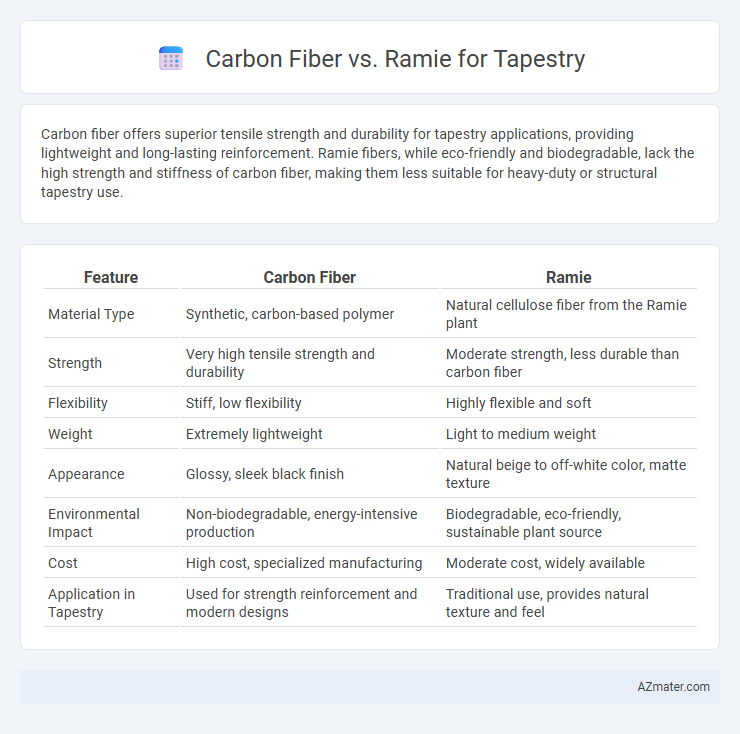Carbon fiber offers superior tensile strength and durability for tapestry applications, providing lightweight and long-lasting reinforcement. Ramie fibers, while eco-friendly and biodegradable, lack the high strength and stiffness of carbon fiber, making them less suitable for heavy-duty or structural tapestry use.
Table of Comparison
| Feature | Carbon Fiber | Ramie |
|---|---|---|
| Material Type | Synthetic, carbon-based polymer | Natural cellulose fiber from the Ramie plant |
| Strength | Very high tensile strength and durability | Moderate strength, less durable than carbon fiber |
| Flexibility | Stiff, low flexibility | Highly flexible and soft |
| Weight | Extremely lightweight | Light to medium weight |
| Appearance | Glossy, sleek black finish | Natural beige to off-white color, matte texture |
| Environmental Impact | Non-biodegradable, energy-intensive production | Biodegradable, eco-friendly, sustainable plant source |
| Cost | High cost, specialized manufacturing | Moderate cost, widely available |
| Application in Tapestry | Used for strength reinforcement and modern designs | Traditional use, provides natural texture and feel |
Introduction to Carbon Fiber and Ramie in Tapestry
Carbon fiber offers exceptional strength-to-weight ratio and durability, making it ideal for high-performance tapestry applications requiring structural support and longevity. Ramie, a natural bast fiber derived from the stalks of the Chinese nettle plant, provides a soft texture and excellent breathability, favored for eco-friendly and traditional tapestry crafts. Combining carbon fiber with ramie can enhance tapestry resilience while maintaining aesthetic appeal and environmental sustainability.
Material Origins: Synthetic vs. Natural Fibers
Carbon fiber originates from synthetic polymers such as polyacrylonitrile, produced through high-temperature carbonization processes resulting in exceptional strength and rigidity. Ramie is a natural fiber derived from the stalks of the Ramie plant (Boehmeria nivea), valued for its silk-like luster and biodegradability. The synthetic origin of carbon fiber yields high tensile strength and durability, whereas ramie's natural origin offers breathability and eco-friendly characteristics ideal for traditional tapestry applications.
Physical Properties: Strength and Flexibility
Carbon fiber exhibits superior tensile strength, often exceeding 3,500 MPa, making it highly resistant to stretching and deformation, while Ramie demonstrates moderate strength around 400 MPa but maintains notable durability. In terms of flexibility, Ramie fibers offer better pliability and natural resilience, allowing for intricate weaving and draping in tapestry applications, whereas carbon fiber's rigidity limits its use where softness or detailed bending is required. The combination of carbon fiber's exceptional strength and Ramie's flexible texture can be strategically utilized to optimize both durability and aesthetic appeal in tapestry creations.
Texture and Visual Appeal in Tapestries
Carbon fiber offers a sleek, smooth texture with a subtle sheen that enhances modern, futuristic tapestry designs. Ramie provides a natural, coarse texture with a matte finish, adding rustic charm and organic visual appeal to tapestries. The choice between carbon fiber and ramie dramatically influences the tactile experience and aesthetic, with carbon fiber emphasizing precision and ramie highlighting earthy warmth.
Weight and Handling Differences
Carbon fiber tapestries are significantly lighter than ramie, offering enhanced ease of handling during installation and maintenance. The high tensile strength of carbon fiber allows for thinner, more flexible tapestries without compromising durability, whereas ramie tends to be bulkier and stiffer. This weight advantage of carbon fiber results in less structural load and improved maneuverability, especially in large-scale or intricate tapestry applications.
Durability and Longevity Comparison
Carbon fiber offers significantly higher durability and longevity compared to ramie due to its exceptional tensile strength and resistance to environmental degradation. While ramie is a natural fiber with decent durability, it is more susceptible to wear, moisture damage, and UV exposure, reducing its lifespan in tapestry applications. Carbon fiber's resistance to corrosion and fatigue makes it ideal for tapestries requiring long-term structural integrity and minimal maintenance.
Environmental Impact and Sustainability
Carbon fiber tapestries have a significantly higher environmental impact due to energy-intensive production and non-biodegradable properties, resulting in long-term waste concerns. Ramie, a natural plant-based fiber, offers a sustainable alternative with low water and pesticide use, biodegradability, and a smaller carbon footprint. Choosing ramie for tapestry production supports eco-friendly practices and reduces reliance on synthetic, resource-heavy materials like carbon fiber.
Cost Considerations: Carbon Fiber vs. Ramie
Carbon fiber tapestries exhibit significantly higher initial costs compared to ramie due to the expensive manufacturing processes and raw materials involved. Ramie offers a cost-effective alternative, benefiting from its natural fiber status and lower production expenses, making it accessible for budget-conscious projects. When balancing durability and price, carbon fiber remains a premium choice, while ramie provides economic value without compromising basic structural integrity.
Artistic Applications and Design Potential
Carbon fiber offers unparalleled strength and a sleek, modern aesthetic for tapestry applications, allowing artists to create lightweight yet durable pieces with sharp, precise lines. Ramie, a natural fiber derived from the nettle plant, provides a rustic texture and excellent dye absorption, enhancing tapestries with rich colors and organic, tactile qualities. The contrasting properties of carbon fiber's rigidity and ramie's softness open innovative design possibilities, enabling creators to blend contemporary minimalism with traditional craftsmanship in artistic textiles.
Conclusion: Choosing the Right Fiber for Tapestry
Choosing the right fiber for tapestry depends on the desired durability and aesthetic qualities. Carbon fiber offers exceptional strength, lightweight properties, and modern appeal, making it ideal for contemporary, high-performance tapestries. Ramie, a natural, eco-friendly fiber, provides a textured, earthy look with good breathability, suitable for traditional or artisanal tapestry projects emphasizing sustainability.

Infographic: Carbon fiber vs Ramie for Tapestry
 azmater.com
azmater.com